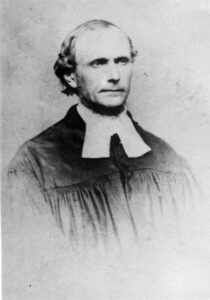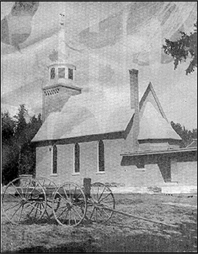
Pastor Ludwig Hermann Gerndt
A complete account of the attraction of suitable German immigrants to the Ottawa Valley can be found in Peter Hessel’s book “Destination: Ottawa Valley.” For our purposes, we may note that the majority of settlers came from the northeastern portion of the German Confederation: Saxony, Silesia, Brandenburg, Posen, Mecklenburg-Schwerin, Mecklenburg-Strelitz, Pomerania, and East and West Prussia. Driven by conditions in Germany, attracted by the words of immigration agents, and lured by the promises of Canada, they made the long journey into a far and distant land, searching for a better way of life for themselves and their families. Having settled in their new country, they petitioned the Evangelical Lutheran Canada Conference for German religious support, as none was available to them.
Based on this correspondence, Pastor Ludwig Hermann Gerndt was appointed as “exploring Missionary” for the Ottawa Valley by the Conference. He had a great deal of experience in missionary work. He was born in Berlin on July 18, 1821. He had been a missionary in India for ten years (1847 – 1857), leaving due to the Indian Mutiny before his arrival in Canada. His mandate was to go into the Pembroke (or Upper Ottawa) District and preach to the scattered Lutheran settlers in the townships of Petawawa, Alice and Wilberforce, and to the inhabitants of Pembroke, Renfrew, Denbigh and Ladysmith, Quebec. He would preach to them in the German language, and he would organize them into properly affiliated congregations. One of these congregations would be St. John’s Evangelical Lutheran Church Petawawa.
It is interesting to refer to a modern map showing the locations listed above. The area outlined by them is huge. The straight-line distances alone are intimidating. Pembroke to Ladysmith: 60 km. Pembroke to Denbigh: 77 km. Denbigh to Ladysmith: 90 km. Add in to the equation the additional area north toward Petawawa and you have a very large area to cover. A rough calculation obtains an area of about 2340 square kilometers, or just over 900 square miles. Now consider the conditions facing the redoubtable Pastor Gerndt: roads of packed earth or gravel, virtually snowbound in the winter; travel by horseback, buggy or, if necessary, by foot… It would take a special person to meet and overcome these conditions and still be a positive force in the lives of his far-flung parishioners.

Pastor Gerndt’s “Democrat”
Initially, he walked or rode a horse, but by 1869 he had acquired a horse-drawn wagon with which he could cover his territory much more efficiently. The wagon was either named “Democrat” or was a model called a “Democrat.” He conducted the first Lutheran services in Pembroke in 1863. By 1868, he had founded eight congregations (one of which was to become St. John’s Petawawa, in 1867) while he continued to travel and preach. In 1869, an assistant, Reverend F. W. Franke, was sent to work with Pastor Gerndt, as the parish had grown so much over the past several years.
Pastor Gerndt made an indelible impression on many of those with whom he came into contact. This is borne out by the following testimonials:
“This man seems to stand out in all references to him by persons both living and dead as an outstanding, respected and beloved leader. Many were the accomplishments of Pastor Gerndt…”
“Reverend Gerndt laboured unceasingly in his large parish, travelling from place to place in the most primitive manner, enduring hardships and privation, searching for and gathering the small groups of Lutherans, and thus laying the foundations on which the now-flourishing congregations were established.”
Pastor Gerndt left Eastern Ontario in 1870 to continue his career in the United States. By that time, he had over 1000 congregational members in his care. He ultimately ended his long career as the pastor at the immigration centre at Ellis Island, New York. He passed away in Brooklyn, New York on January 15, 1905.